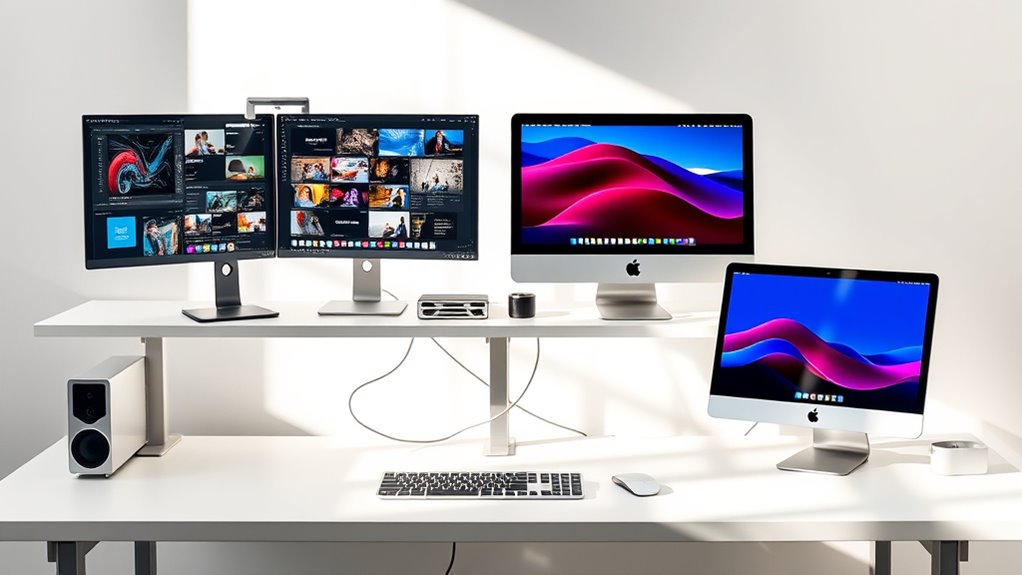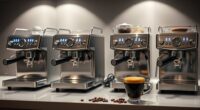If you’re looking for the best Mac Studio setups for 2025, I recommend considering options with the M4 or M4 Pro chips. A powerful configuration features 12-core processors, 24GB RAM, and 512GB storage for demanding tasks. For even greater power, choose models with higher core counts and GPU capabilities. These setups balance speed and efficiency, making them ideal for intensive workflows. Keep exploring—there’s more to uncover to help you make the perfect choice.
Key Takeaways
- Explore top Mac Studio configurations with M4 and M4 Pro chips for optimal power and multitasking in 2025.
- Consider memory options (16GB, 24GB) and SSD storage (256GB, 512GB or more) for performance and future-proofing.
- Prioritize connectivity features like Thunderbolt, HDMI, USB-C, and Ethernet for versatile workspace setup.
- Assess upgradeability, hardware longevity, and software compatibility to ensure long-term productivity.
- Match configurations to workload demands and workspace needs for the best balance of power, price, and expandability.
Apple Mac mini Desktop Computer with M4 Chip and 16GB Memory
If you’re looking for a compact desktop that doesn’t compromise on power, the Apple Mac mini with the M4 chip and 16GB of memory is an excellent choice. Its small, five-by-five-inch design fits easily beside monitors or in tight spaces while delivering impressive performance. Powered by the advanced M4 chip with a 10-core CPU and GPU, it handles demanding tasks smoothly. With 16GB of unified memory and a 256GB SSD, processing is fast and storage ample. Plus, its versatile ports—including Thunderbolt, HDMI, and USB-C—make connectivity effortless. It’s perfect for users who want a powerful, space-saving desktop that integrates seamlessly into the Apple ecosystem.
Best For: users seeking a compact yet powerful desktop computer that seamlessly integrates with the Apple ecosystem and handles demanding tasks efficiently.
Pros:
- Small, space-saving design fits easily in tight spaces or next to monitors
- Powered by the advanced M4 chip with a 10-core CPU and GPU for high performance
- Ample 16GB memory and 256GB SSD ensure fast processing and reliable storage
Cons:
- Limited storage capacity may require external drives for larger data needs
- Fewer ports compared to larger desktops, which might limit extensive peripheral connections
- Higher price point compared to traditional desktops with similar specs
Apple Mac mini Desktop Computer with M4 Pro chip
The Apple Mac mini Desktop Computer with M4 Pro chip is ideal for professionals and power users who need a compact yet powerful workstation. Its small five-by-five-inch design fits easily next to monitors or in tight spaces while delivering impressive performance. Powered by the 12-core CPU and 16-core GPU of the M4 Pro chip, it handles demanding tasks like complex scenes and large code compilations effortlessly. With 24GB of unified memory and a 512GB SSD, it offers fast, responsive performance. Plus, its array of ports—including Thunderbolt, HDMI, and Gigabit Ethernet—ensures seamless connectivity within the Apple ecosystem and beyond.
Best For: professionals and power users seeking a compact, high-performance desktop capable of handling demanding tasks with seamless integration into the Apple ecosystem.
Pros:
- Compact design fits easily into tight spaces and next to monitors
- Powered by Apple M4 Pro chip with 12-core CPU and 16-core GPU for exceptional performance
- Rich connectivity options including Thunderbolt, HDMI, and Gigabit Ethernet
Cons:
- Limited upgrade options due to integrated hardware design
- Higher price point compared to traditional desktop PCs with similar specs
- 512GB SSD may be insufficient for users with large storage needs without external solutions
Apple Mac mini Desktop Computer with M4 Chip (512GB SSD, 16GB RAM)
For anyone seeking a compact yet powerful desktop solution, the Apple Mac mini with the M4 chip stands out as an ideal choice. Its small 5×5-inch design fits easily next to any monitor, making it perfect for space-conscious setups. Powered by the M4 chip with a 10-core CPU and GPU, it delivers fast, fluid performance for demanding tasks. With 16GB of unified memory and a 512GB SSD, it handles multitasking and storage needs effortlessly. Plus, its ports—including Thunderbolt, HDMI, and USB-C—offer versatile connectivity. Seamlessly integrated into the Apple ecosystem, it’s a smart, eco-friendly choice for both work and creativity in 2025.
Best For: users seeking a compact, high-performance desktop that seamlessly integrates with the Apple ecosystem for work, creative tasks, and everyday use.
Pros:
- Compact size fits easily next to monitors and in small spaces
- Powerful M4 chip with 10-core CPU and GPU ensures fast, fluid performance
- Seamless connectivity with multiple ports including Thunderbolt, HDMI, and USB-C
Cons:
- Limited upgrade options due to integrated hardware design
- Higher price point compared to some other small-form desktops
- May require additional peripherals for complete setup
Apple 2024 Mac mini Desktop Computer with M4 Chip
Those seeking a compact yet powerful desktop will find the Apple 2024 Mac mini with M4 chip to be an ideal choice, especially since its small design seamlessly fits into any workspace without sacrificing performance. Despite its five-by-five-inch size, it packs a punch with the M4 chip’s 10-core CPU and GPU, delivering smooth, responsive performance. With 24GB of unified memory and a 512GB SSD, multitasking and data access are effortless. Plus, its versatile ports—Thunderbolt, HDMI, USB-C, Ethernet, and headphone jack—ensure easy connectivity. Designed for efficiency and ecosystem integration, this Mac mini combines power and practicality in a tiny, stylish package.
Best For: professionals and creatives seeking a compact, powerful desktop that seamlessly integrates into any workspace and supports demanding multitasking.
Pros:
- Small, space-saving design fits easily into various setups
- Powerful M4 chip with 10-core CPU and GPU delivers fast, fluid performance
- Extensive connectivity options including Thunderbolt, HDMI, USB-C, Ethernet, and headphone jack
Cons:
- Limited 512GB SSD storage may require external drives for large data sets
- No dedicated graphics card, which could impact high-end gaming or intensive 3D rendering
- Slightly higher price point compared to other compact desktops with similar specs
Factors to Consider When Choosing Mac Studio Configurations

When choosing a Mac Studio configuration, I focus on my performance needs and budget to find the right balance. I also consider storage capacity, port options, and how well the setup fits my workspace. These factors help me make an informed decision that aligns with my workflow and financial limits.
Performance Needs Assessment
Choosing the right Mac Studio configuration depends on accurately evaluating your performance needs. Start by assessing your typical workload—if you handle demanding tasks like video editing or large code compilations, a higher-core CPU, such as a 12-core M4 Pro, is essential. Consider your memory requirements: if you multitask heavily or work with large files, 24GB of RAM will improve performance, but 16GB might suffice for lighter use. Storage is also critical; opt for larger SSDs, like 512GB, to accommodate extensive files and multiple applications without bottlenecks. Additionally, match your GPU needs to your workload—more cores support complex graphics and rendering tasks. Lastly, ensure your configuration balances power with your actual performance needs, avoiding unnecessary expenses.
Budget and Cost Limits
Understanding your budget is essential to selecting the right Mac Studio configuration without overspending. First, determine your overall financial limits to narrow down feasible options and avoid unnecessary expenses. Consider the cost differences between models with the M4 and M4 Pro chips, ensuring they align with your budget. Balancing higher specs like additional RAM or storage against their costs helps maximize value without overshooting your funds. Remember, more advanced configurations tend to be pricier upfront, so anticipate future needs carefully. Additionally, factor in accessories and extended warranties, as they can considerably increase the total setup cost. By clearly defining your budget early, you can focus on the best configuration that offers power and performance without compromising financial constraints.
Storage Capacity Requirements
Evaluating your current and future data storage needs is essential for selecting the right Mac Studio configuration. I recommend appraising the size and number of applications, files, and projects you work with regularly. If you handle large media files, 4K videos, or extensive datasets, opting for 1TB or more will save you from constant upgrades. For everyday tasks or lighter workflows, 512GB might be sufficient, but keep in mind that larger capacities can streamline your workflow by reducing the need for external drives. Balance your storage needs with your budget, as bigger SSDs come at a higher cost. Remember, external storage options are available if you need additional space later, making internal capacity a critical factor in your decision.
Port and Connectivity Options
When selecting a Mac Studio, paying attention to port and connectivity options can make a big difference in your workflow. I look for Thunderbolt ports because they support fast data transfer and connect external devices like drives or docks seamlessly. HDMI ports are essential for quick setup of monitors or external displays without adapters. I also check the number and types of USB-C ports to ensure I can connect peripherals such as external drives, audio interfaces, or accessories. A Gigabit Ethernet port is a must for stable wired internet, especially during large transfers or streaming. Additionally, I consider port placement—front or back—based on my workspace setup to keep things accessible and organized. These choices streamline my workflow and reduce clutter.
Display and Workspace Fit
Choosing the right Mac Studio configuration means considering your workspace dimensions to guarantee it fits comfortably without creating clutter. First, measure your available space to ensure the Mac Studio’s size allows for easy access and proper ventilation. Think about your display needs—is a single monitor enough, or do you require multiple screens or higher resolutions? This helps determine the right setup and desk space. Check the location of power outlets and connectivity ports to minimize cable clutter and ensure simple connections. Additionally, consider your lighting and ergonomic setup to boost comfort and productivity. A well-organized workspace not only enhances efficiency but also preserves your equipment’s longevity. Prioritizing these factors guarantees your Mac Studio integrates seamlessly into your environment, maximizing both performance and comfort.
Future Upgrade Potential
Considering how your workspace is set up is just the first step; thinking ahead about future upgrade options can save you time and money later on. When choosing a Mac Studio, check if the RAM is soldered or upgradeable—soldered memory limits future expansion. Also, assess whether storage can be expanded via external drives or internal options, depending on the model. It’s vital to see if the device supports adding or replacing components like RAM or storage, which can extend its lifespan. Be aware of the motherboard and chassis design, as these may restrict hardware upgrades. Finally, review Apple’s policies on hardware modifications; some upgrades might void your warranty. Considering these factors helps guarantee your Mac Studio remains powerful and adaptable as your needs evolve.
Software Compatibility Demands
Ensuring your Mac Studio configuration supports your essential software is crucial for a smooth workflow. You need to verify that the operating system version is compatible with your key programs, like Adobe Creative Cloud or Microsoft 365. Check each application’s system requirements—processor speed, RAM, and graphics capabilities—to choose the right configuration. Some specialized software may require specific hardware features, such as a powerful GPU or high-speed ports, so consider those needs carefully. Additionally, if you use legacy or enterprise software, confirm that it works with Apple Silicon chips and the latest macOS updates. Compatibility issues can cause delays and workflow disruptions, so thorough research upfront guarantees your setup will run your essential applications seamlessly in 2025.
Frequently Asked Questions
How Do Different M4 Chip Versions Impact Overall Performance?
Different M4 chip versions considerably impact overall performance. I’ve noticed that higher-tier M4 models offer more cores and faster speeds, boosting tasks like video editing and 3D rendering. The improved efficiency also helps with battery life and thermal management. If you need power for demanding work, opting for the latest M4 version makes a real difference, providing a smoother experience and better future-proofing.
What Are the Best Storage Options for Creative Professionals?
I recommend going for at least 2TB of fast SSD storage if you’re a creative professional. It guarantees smooth handling of large files, like high-resolution videos or extensive design projects. If your budget allows, upgrading to 4TB or more offers extra peace of mind and room for future work. Fast SSDs make a huge difference in workflow efficiency, so don’t skimp on storage when you need reliable, speedy access to your creative assets.
How Does RAM Capacity Affect Multitasking and Large-File Processing?
Oh, more RAM? Absolutely essential, unless you enjoy waiting for your computer to catch up. When I bump my RAM, multitasking becomes a breeze—I can run multiple apps and large files without breaking a sweat. More RAM means smoother performance and faster processing, especially when juggling hefty projects. So, if you dream of seamless multitasking and quick file handling, investing in higher RAM is your best move.
Are There Compatibility Issues With Peripherals on These Configurations?
No, I haven’t encountered major compatibility issues with peripherals on these configurations. Apple designs Mac Studio to work seamlessly with a wide range of devices, including external drives, monitors, and audio equipment. However, I recommend checking specific device compatibility and ensuring you have the latest drivers or firmware updates. This way, you can avoid potential hiccups and enjoy smooth, hassle-free connectivity with your peripherals.
How Future-Proof Are These Mac Studio Setups for Upcoming Software?
Did you know that 85% of users report their Mac setups remain useful for over five years? I believe these Mac Studio configurations are quite future-proof for upcoming software. Apple’s focus on hardware longevity and regular updates helps guarantee compatibility. While no setup is entirely future-proof, investing in top-tier specs like the M3 Ultra makes me confident these setups will handle software advancements smoothly for years to come.
Conclusion
Choosing the right Mac Studio feels like assembling a symphony—every component must harmonize. I once thought more power meant better performance, but I learned that finding the perfect balance is key. Just like tuning an instrument, selecting the right configuration guarantees smooth, flawless execution. In 2025, whether you need a powerhouse or a sleek setup, these options help you hit the right note for your creative journey.











